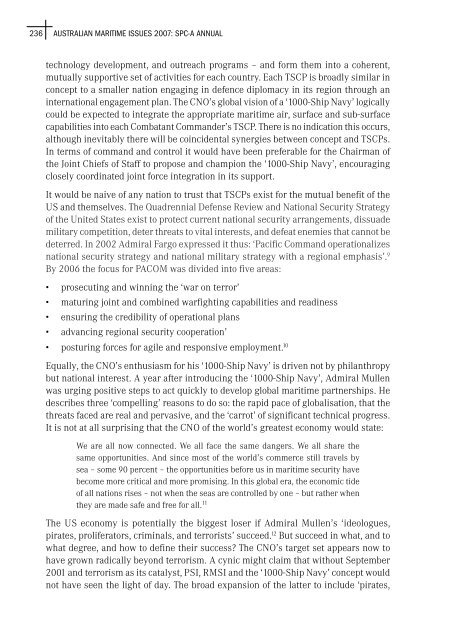Australian Maritime Issues 2007 - Royal Australian Navy
Australian Maritime Issues 2007 - Royal Australian Navy
Australian Maritime Issues 2007 - Royal Australian Navy
You also want an ePaper? Increase the reach of your titles
YUMPU automatically turns print PDFs into web optimized ePapers that Google loves.
236 AUSTRALIAN MARITIME ISSUES <strong>2007</strong>: SPC-A ANNUAL<br />
technology development, and outreach programs – and form them into a coherent,<br />
mutually supportive set of activities for each country. Each TSCP is broadly similar in<br />
concept to a smaller nation engaging in defence diplomacy in its region through an<br />
international engagement plan. The CNO’s global vision of a ‘1000-Ship <strong>Navy</strong>’ logically<br />
could be expected to integrate the appropriate maritime air, surface and sub-surface<br />
capabilities into each Combatant Commander’s TSCP. There is no indication this occurs,<br />
although inevitably there will be coincidental synergies between concept and TSCPs.<br />
In terms of command and control it would have been preferable for the Chairman of<br />
the Joint Chiefs of Staff to propose and champion the ‘1000-Ship <strong>Navy</strong>’, encouraging<br />
closely coordinated joint force integration in its support.<br />
It would be naive of any nation to trust that TSCPs exist for the mutual benefit of the<br />
US and themselves. The Quadrennial Defense Review and National Security Strategy<br />
of the United States exist to protect current national security arrangements, dissuade<br />
military competition, deter threats to vital interests, and defeat enemies that cannot be<br />
deterred. In 2002 Admiral Fargo expressed it thus: ‘Pacific Command operationalizes<br />
national security strategy and national military strategy with a regional emphasis’. 9<br />
By 2006 the focus for PACOM was divided into five areas:<br />
• prosecuting and winning the ‘war on terror’<br />
• maturing joint and combined warfighting capabilities and readiness<br />
• ensuring the credibility of operational plans<br />
• advancing regional security cooperation’<br />
• posturing forces for agile and responsive employment. 10<br />
Equally, the CNO’s enthusiasm for his ‘1000-Ship <strong>Navy</strong>’ is driven not by philanthropy<br />
but national interest. A year after introducing the ‘1000-Ship <strong>Navy</strong>’, Admiral Mullen<br />
was urging positive steps to act quickly to develop global maritime partnerships. He<br />
describes three ‘compelling’ reasons to do so: the rapid pace of globalisation, that the<br />
threats faced are real and pervasive, and the ‘carrot’ of significant technical progress.<br />
It is not at all surprising that the CNO of the world’s greatest economy would state:<br />
We are all now connected. We all face the same dangers. We all share the<br />
same opportunities. And since most of the world’s commerce still travels by<br />
sea – some 90 percent – the opportunities before us in maritime security have<br />
become more critical and more promising. In this global era, the economic tide<br />
of all nations rises – not when the seas are controlled by one – but rather when<br />
they are made safe and free for all. 11<br />
The US economy is potentially the biggest loser if Admiral Mullen’s ‘ideologues,<br />
pirates, proliferators, criminals, and terrorists’ succeed. 12 But succeed in what, and to<br />
what degree, and how to define their success? The CNO’s target set appears now to<br />
have grown radically beyond terrorism. A cynic might claim that without September<br />
2001 and terrorism as its catalyst, PSI, RMSI and the ‘1000-Ship <strong>Navy</strong>’ concept would<br />
not have seen the light of day. The broad expansion of the latter to include ‘pirates,
















